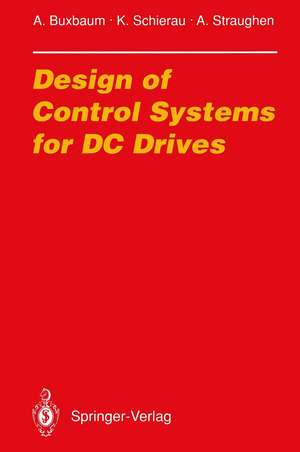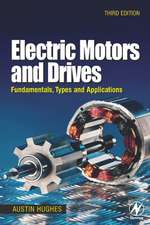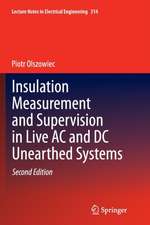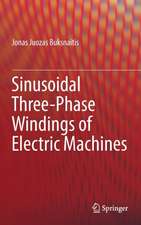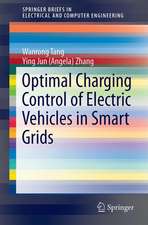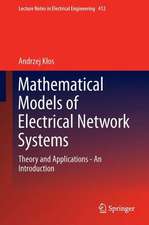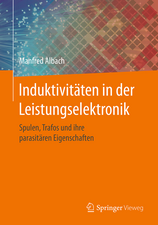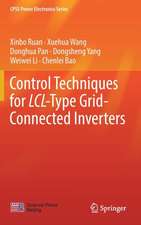Design of Control Systems for DC Drives: Electric Energy Systems and Engineering Series
Autor Arne Buxbaum Editat de R. Bonert Autor Klaus Schierau, Alan Straughenen Limba Engleză Paperback – 9 apr 2012
Preț: 638.89 lei
Preț vechi: 751.64 lei
-15% Nou
Puncte Express: 958
Preț estimativ în valută:
122.27€ • 127.18$ • 100.94£
122.27€ • 127.18$ • 100.94£
Carte tipărită la comandă
Livrare economică 14-28 aprilie
Preluare comenzi: 021 569.72.76
Specificații
ISBN-13: 9783642840081
ISBN-10: 3642840086
Pagini: 264
Ilustrații: XXII, 237 p. 3 illus.
Dimensiuni: 155 x 235 x 14 mm
Greutate: 0.38 kg
Ediția:Softcover reprint of the original 1st ed. 1990
Editura: Springer Berlin, Heidelberg
Colecția Springer
Seria Electric Energy Systems and Engineering Series
Locul publicării:Berlin, Heidelberg, Germany
ISBN-10: 3642840086
Pagini: 264
Ilustrații: XXII, 237 p. 3 illus.
Dimensiuni: 155 x 235 x 14 mm
Greutate: 0.38 kg
Ediția:Softcover reprint of the original 1st ed. 1990
Editura: Springer Berlin, Heidelberg
Colecția Springer
Seria Electric Energy Systems and Engineering Series
Locul publicării:Berlin, Heidelberg, Germany
Public țintă
Professional/practitionerCuprins
1. Normalization.- 2. Signal Flow Diagram.- 3. Open-Loop Control.- 3.1 Basic Concepts.- 3.2 Example of a Calculation.- 4. Basic Concepts and Definitions of Feedback Control.- 4.1 Basic Principle of a Feedback Control.- 4.2 The Feedback Control System.- 4.3 Control Requirements.- 5. Calculation of Feedback Control in the Steady-State.- 5.1 Amplification.- 5.2 Steady-State Closed-Loop Amplification.- 5.3 Additive and Multiplicative Disturbances.- 5.4 Basis of Calculation.- 5.5 Controllable and Noncontrollable Errors.- 5.6 Example.- 6. Basic Mathematics of Dynamic Control.- 6.1 Differential Equations (DE’s).- 6.2 Equations of Irrational Elements.- 6.3 Example.- 7. Unit Step Response.- 7.1 Definition.- 7.2 Unit Step Response of Common Control-Circuit Elements.- 7.3 Significance of the unit Step Response.- 8. Sinusoidal Transfer Function.- 8.1 Transformation of DE’s into Transfer-Function Equations.- 8.2 Sinusoidal and Laplace Transfer Functions.- 8.3 Transfer Function and Complex AC Analysis.- 8.4 Transfer Functions of Common Control-Circuit Elements.- 8.5 Example.- 9. System Diagram.- 9.1 Symbolic Representation of Control-System Elements.- 9.2 Example.- 10. Conversion of System Diagrams and Transfer Functions.- 10.1 Conversion Rules for Rational Elements.- 10.2 Conversion Rules for Irrational Elements.- 10.3 Negative and Positive Feedback.- 10.4 Resolution of Control-System Elements into P- and I-Elements.- 10.5 Conversion of a TD2-Element.- 11. Stability.- 11.1 Definition.- 11.2 Stability Analysis of Positive Feedback.- 11.3 Stability Criteria.- 11.4 The Nyquist Criterion.- 12. Use of Bode Diagrams.- 12.1 Bode Diagrams.- 12.2 Bode Diagrams of Common Control-System Elements.- 12.3 Rules for Calculation.- 12.4 Curve-Drawing Instrument.- 12.5 Stability Analysis by BodeDiagram.- 13. Stabilization of Control Systems without an I-Element in the Controlled System.- 13.1 P-Controller.- 13.2 I-Controller.- 13.3 PI-Controller.- 13.4 PD-Controller.- 13.5 PID-Controller.- 14. Stabilization of Control Systems with an I-Element in the Controlled System.- 14.1 P- and PD-Controllers.- 14.2 I-Controller.- 14.3 PI-Controller.- 14.4 PID-Controller.- 15. Closed Control Loops.- 15.1 Calculation.- 15.2 Approximation Procedure.- 15.3 Nichols Chart.- 16. Normalized Bode Diagrams and Step Responses.- 16.1 Sum of Small Time Constants.- 16.2 Systems with an I-Element in the Controlled System.- 16.3 System without an I-Element in the Controlled System.- 16.4 Summary.- 17. Improvement of Dynamic Behaviour by Internal Loops.- 18. Programming Control Systems on the Analog Computer.- 18.1 Computer Elements.- 18.2 Basis of Programming.- 18.3 Example.- 19. Programming Control Systems on the Digital Computer.- 19.1 Basic Principle.- 20. Hints on Calculating Bode Diagrams with the Digital Computer.- 20.1 Determination of Amplitude and Phase Angle.- 20.2 Amplitude and Phase Angle of the Most Important Control System Elements.- 21. Connection of Control Amplifiers.- 21.1 Negative Feedback.- 21.2 Basic Connections.- 21.3 Controller Connections.- 21.4 Special Connections.- 21.5 Control Amplifier Errors.- 22. Static and Dynamic Characteristics of Line-Commutated Rectifiers.- 22.1 Static Characteristic.- 22.2 Internal Resistance.- 22.3 Dynamic Behaviour.- 22.4 Representation in the System Diagram.- 23. System Diagram of the dc Drive.- 23.1 System Diagram for Variable Field Excitation.- 23.2 System Diagram for Constant Field Excitation.- 24. Speed Control of a Converter Drive with Current Feedback.- 24.1 Connection Diagram.- 24.2 System Diagram.- 24.3 Current Control.- 24.4 Speed Control.- 24.5 Making Allowance for the EMF-Loop.- 25. Voltage Control of Converter Drives.- 25.1 Simple Voltage Control.- 25.2 Voltage Control with Current Feedback.- 25.3 Comments on the System Diagram.- 26. Control of Ward-Leonard Drives.- 26.1 Speed Control with Current Feedback.- 26.2 Speed Control with Current Feedback and Exciter-Current Control.- 27. Speed Control by Field Weakening.- 28. Control with an Oscillatory Mechanical System.- 28.1 System Diagram of an Undamped Two-Mass System.- 28.2 System Diagram of a Damped Two-Mass System.- 28.3 Bode Diagram and Dynamic Behaviour.- 28.4 Determination of Characteristic Values.- 28.5 Measures to Improve Dynamic Behaviour.- 29. Superimposed Control Systems.- 29.1 Control of Tension.- 29.2 Control of a Loop.- 29.3 Control by Level Gauge.- 29.4 Positional Control.- 30. Adaptive Controllers in Drive Systems.- 30.1 Speed Control by Motor Field Weakening.- 30.2 Control of Converter Drives with Discontinuous and Continuous Armature Current.- 30.3 Adaptive Speed Controller with Variation of the Run-Up Time Constant.- 31. Digital Control.- 31.1 Digital Feedback Control.- 31.2 The z-Transform.- 31.3 The z-Transform Function of a P-, PI- and PID-Controller.- 31.4 Example of a Digital Control.- References.- Fig. 4 Nichols Chart.- Table 4 The most Important Controller Connections.- Table 5 The most Important Control-System Elements.
